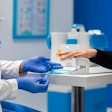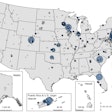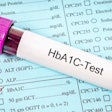
University of Michigan researchers conducted a diagnostic study to investigate the potential of portable breath-based volatile organic compound monitors for COVID-19 detection. The research, published on Tuesday in JAMA Network Open, may facilitate the use of breath analysis as a noninvasive means to detect COVID-19.
Breath exhalations contain hundreds of volatile organic compounds (VOCs) -- many of which may be produced in response to inflammation and infection. However, the impact of emerging SARS-CoV-2 variants on the exhaled breath profile and breath analysis accuracy is unknown. The researchers sought to evaluate the diagnostic accuracy of breath analysis in detecting COVID-19 at a time when the SARS-CoV-2 Delta and Omicron variants were prevalent.
Their diagnostic study included a cohort of 167 patients who had both positive and negative test results for COVID-19 using reverse transcriptase–polymerase chain reaction (RT-PCR) tests between April 2021 and May 2022, the period in which the Delta variant was overtaken by Omicron as the predominant variant. Patients were enrolled through intensive care units and the emergency department at the University of Michigan Health System. Their breath was analyzed with portable gas chromatography.
Different sets of VOC biomarkers were identified that distinguished between COVID-19 (both Delta and Omicron variants) and non–COVID-19 illness. Overall, 205 breath samples from the 167 adult patients were analyzed. A total of 77 patients with COVID-19 participated. Their mean age was 58.5 years; 41 (53.2%) were male; 13 (16.9%) were Black, and 59 (76.6%) white. A total of 91 patients had non–COVID-19 illness. Their mean age was 54.3 years; 43 (47.3%) were male; 11 (12.1%) were Black, and 76 (83.5%) white. A portable gas chromatography monitor was developed as a point-of-care diagnostic modality.
Among 94 positive samples, 41 samples were from patients in 2021 infected with Delta or other variants, and 53 samples were from patients in 2022 infected with the Omicron variant. Four VOC biomarkers were found to distinguish between COVID-19 (Delta and other 2021 variants) and non–COVID-19 illness with an accuracy of 94.7%. However, the accuracy rate dropped substantially to 82.1% when these biomarkers were applied to the Omicron variant. Therefore, a different set of VOCs were required to distinguish between Omicron and non–COVID-19 illness. Four new VOC biomarkers were found to make this distinction with an accuracy of 90.9%. Breath analysis distinguished Omicron from earlier variants with an accuracy of 91.5%, and COVID-19 (all variants) versus non–COVID-19 illness with 90.2% accuracy.
The findings indicate that the team's breath analysis technology holds promise for COVID-19 detection. However, as with rapid antigen testing, the emergence of new variants poses diagnostic challenges. While breath analysis may distinguish between COVID-19 and non–COVID-19 illness, it also reveals significant breath profile variations among COVID-19 patients as new SARS-CoV-2 variants emerge. Further research may help overcome these challenges so that the breath analysis technology can best be utilized to improve the diagnosis and care of COVID-19 patients.



















